Shopify is easily the best known e-commerce platform around, but that doesn’t mean it provides the best solution for everyone. While SamCart, the younger cousin, may have some catching up to do in order to amass the same number of users as Shopify – it’s a very viable alternative.
In this Shopify vs. SamCart comparison, we’re going to dig down to the fine details and look at the key differences between the two platforms. How do they compare in terms of pricing and features available? What features does one have that the other does not? Is it possible to blog effectively on these platforms? These are all questions we hope to answer.
| Shopify vs. SamCart comparison at a glance: | ||
| Shopify | SamCart | |
| Prices |
|
|
| Features |
|
|
| Blogging |
|
|
| Customer Support |
|
|
Table of Contents
What Is Shopify?
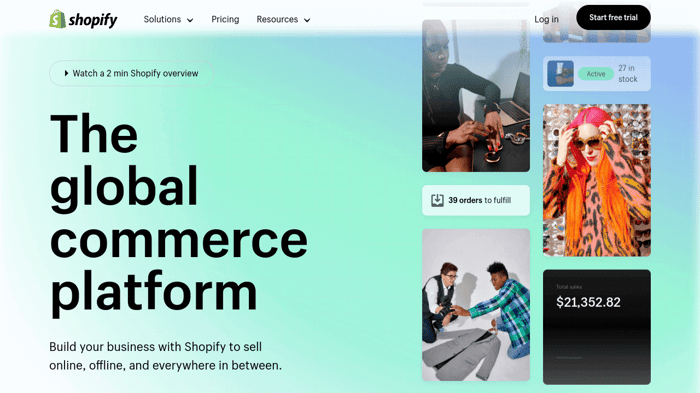
Shopify is probably the leading e-commerce platform on the market – it certainly is one of the best known. It allows you to build an online store from which to sell your products and connect to a traditional brick-and-mortar store.
All the basic components you need to manage an e-commerce store are where you want them, and for anything else, there’s a huge range of possible integrations. Shopify is highly scalable, being suitable for both small businesses and enterprise-scale businesses.
You can start with the lowest-tier plan and upgrade as your business grows. Sell digital products or physical products locally or internationally – it’s made easy with Shopify. The platform has also cornered the market on dropshipping, as it couldn’t be simpler to set up and manage a dropshipping business with Shopify.
What Is SamCart?
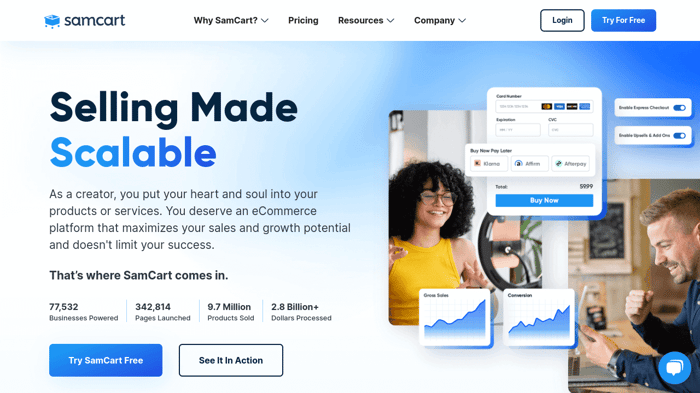
SamCart is the newer of the two platforms and is touted as being built for creators by creators. Similarly to Shopify, it’s possible to sell both digital products and physical ones. However, there’s one key difference with SamCart – it’s a checkout platform, not an online store builder. You can build sales pages, which are something along the lines of landing pages, but not a full-blown storefront like Shopify allows. This comes with some advantages, though, because you don’t have to build and manage an entire online store as well.
SamCart has integrated all the features you need to design beautiful product pages with a functional checkout that can be optimized to reduce the risk of abandoned carts and incomplete sales. It pulls out all the stops to maximize conversions, including functionalities like A/B split testing. It is ideal for those selling small catalogs of products.
Shopify vs. SamCart Pricing in a Nutshell
Shopify
Shopify has three regular paid plans – Basic, Shopify, and Advanced – and a couple of additional plans that give select features and functionality only. There is a free trial, but it only lasts three days. After that, you can “trial” the platform for one month for the symbolic price of $1.
With all the regular plans, you can build an online store, promote and sell your products on multiple channels, accept payments, and access 24/7 customer support.
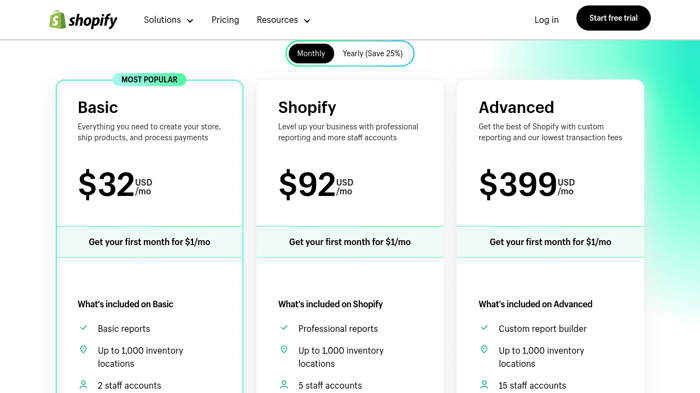
Basic Plan
The Basic plan costs $32/month or $288/year (equivalent to $24/month) and is the most popular plan. It allows two staff accounts and basic reporting.
Even though this is the lowest-tier plan, you’ll be able to list unlimited products, store unlimited contacts, and develop marketing automation. This plan packs a punch and provides everything you need to get started and grow.
Shopify Plan
The Shopify plan is a big price increase at $92/month or $828/year (equivalent to $69/month). With this, you’ll get access to five staff accounts, standard reporting, and specific e-commerce automations. It’s ideal if your business has outgrown the Basic plan and you have a larger team.
Advanced Plan
Another big price jump, and you have the Advanced plan for $399/month or $3,588/year (equivalent to $299/month). The Advanced plan gives you access to 15 staff accounts, advanced reporting, calculated shipping rates, and estimates on duties and taxes.
Additional Plans
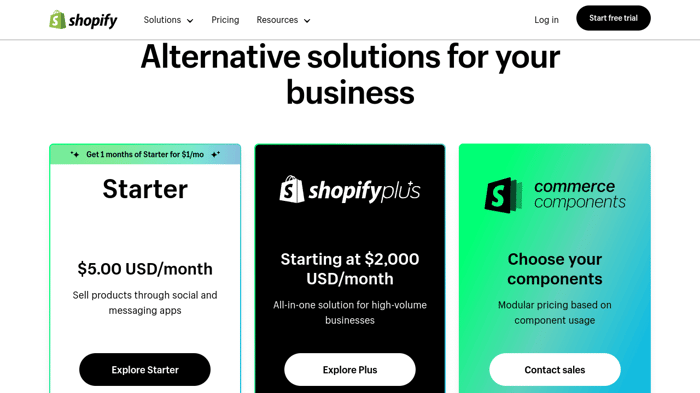
Starter
The Starter plan is only $5/month and allows you to sell products via social media platforms. It means you get a secure checkout, can manage your orders, and get access to sales and customer analytics. It’s a very affordable option for artists or those with a small-scale side hustle.
ShopifyPlus
ShopifyPlus is an enterprise-level plan aimed at large businesses with an existing high volume of customers or those that are on the cusp of scaling. It’s a hefty price tag starting at $2,000/month, but if it fits your budget, it could dramatically improve conversions and rapidly boost your business potential.
Commerce Components
Commerce Components is a pick-and-mix solution offered by Shopify that enables you to select the specific features and functionality you need. It’s completely customized, as is the pricing, so you’ll have to contact Shopify sales for more details.
SamCart
SamCart offers three regular plans and a VIP enterprise-level plan. The three regular pricing plans are: Launch, Grow, and Scale. The platform does allow for a 7-day free trial so you can find your feet before selecting your chosen plan.
All plans come with a range of core features which includes a drag-and-drop page builder, complete with a library of templates and unlimited products and pages. You can have an unlimited number of contacts, unlimited products, and unlimited video uploads. Another nice perk is the 0% payment processing fees.
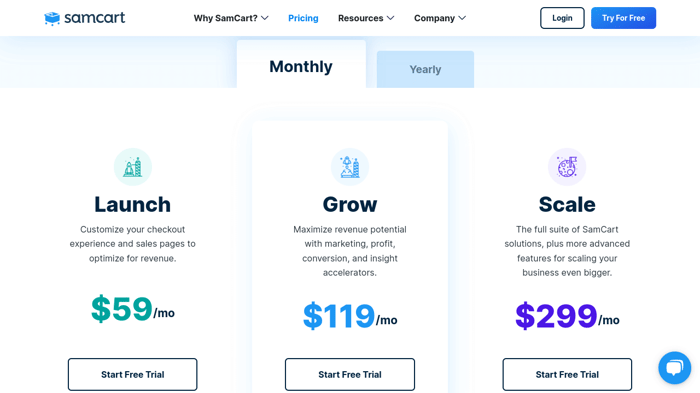
Launch Plan
The Launch plan starts at $59/month or $468/year (equivalent to $39/month), so it’s a little more expensive than the lowest-tier Shopify plan. You’ll get access for one account admin, the Pay What You Want pricing system, as well as the traditional set price. You also get access to the sales reporting dashboard.
Lastly, with this plan, you get access to a host of free training webinars, integrations, and email support as well.
Grow Plan
The Grow plan costs $119/month or $948/year (equivalent to $79/month), and it gives access to three admin users, a one-on-one launch call with a SamCart expert, and email support with a maximum one-day response time. You’ll be able to create customized email campaigns, develop and automate thank you pages and subscription reminders, and upsell products.
The Grow plan also includes enhanced integrations and reporting, as well as white labeling. It is an ideal plan for those looking to maximize revenue and scale their e-commerce business.
Scale Plan
Amongst the three regular pricing plans, the Scale plan is the top-tier option and costs $299/month or $2,388/year (equivalent to $199/month). You will get access for 10 admin users and all features available in the Grow plan. In addition, there are custom CRM and API integrations and priority email support.
This plan is certainly not cheap, but it is targeted at businesses with large revenue streams that want to scale even further.
VIP Enterprise-Level Plan
The VIP plan is entirely personalized to you and your business needs. You have access to all the features available in the Scale plan, as well as the ability to create multiple sub-accounts, which is perfect for agencies.
VIP plan holders get a dedicated SamCart account manager and assistance with technical setup and migration to SamCart. For prices, you’ll have to contact the sales team directly.
Shopify vs. SamCart Features Comparison
Shopify
Easy to Set Up, Difficult to Customize
Shopify was designed with the intention of allowing anybody to set up an online store with ease – and it is indeed easy to set up and start selling. Within minutes you can have your storefront operational and accepting payments. However, the definition of easy to use is subjective, and while the drag-and-drop site builder is simple, you’re very limited in customization options.
Customizations are difficult because the moment you want to do something outside the box, you’ll need to code it yourself. This is where things get tricky because Shopify uses Liquid code, which is not commonly used. You either limit yourself to editing the fonts, colors, and images within your chosen template or you code the look you want yourself.
For anyone that wants to showcase their artistic style in their store, Shopify probably won’t satisfy.
No Limits: Bandwidth, Traffic, or Products
Shopify allows for a great degree of freedom. With each of the regular pricing plans, you can add an unlimited number of products to your store, and you can also store an unlimited number of contacts. You aren’t restricted by the number of visitors to your store or by bandwidth caps.
Numerous Integration Options
Shopify doesn’t actually have a lot of built-in tools. Similarly to WordPress, if you want additional functionality, you’ll need to integrate a third-party app. Luckily, Shopify has a well-organized App Store with thousands of apps to choose from.

There are some downsides to this, though. Adding extra apps can weigh down your site and slow the loading speed. It can also add significant cost because not all apps are available for free.
Wide-Ranging Customer Support
Shopify does provide fantastic customer support that’s available 24/7 to all plan holders, but also in various formats. Support options come in the form of documentation, community forums, or social media accounts.
However, if you need more and you’d prefer to deal with a Shopify representative, there is live chat, email, and phone.
Sell Anything, Anywhere
Shopify really can’t be beaten when it comes to the diversity and flexibility in the type of products you sell and where you sell them. Firstly, you can sell digital products, dropship physical products, or connect your Shopify store to a physical brick-and-mortar store.
In addition, you can sell your products on a variety of other platforms, including social media. Shopify is compatible with international sales, so you can sell to customers anywhere around the globe and even use the language translation functionality.
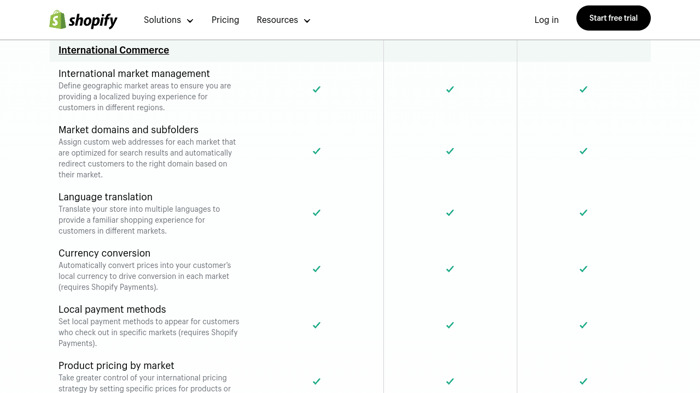
Additional Costs
One thing to note is that once you pay your subscription fees, the costs don’t necessarily end there. Shopify does have some additional costs, for example, payment processing fees, paid themes, or paid apps.
If you opt to use Shopify Payments, then there are no payment processing fees. However, if you choose a third-party payment processor, fees per transaction range from 2% for the Basic to 1% for Shopify and 0.5% for Advanced plan holders.
SamCart
More Than a Checkout, But Not Quite a Site Builder
SamCart is technically a shopping cart platform. You don’t necessarily build an online storefront or website, yet you can sell your products from product pages that act like a website.
The drag-and-drop editor is easy to use, and there is a wide selection of well-designed templates to work from. SamCart generally gives you more ability to customize your pages how you want them – and definitely no coding required.
Because you don’t have a full site builder with SamCart, there is the possibility to embed your SamCart checkouts and product pages within a website that you’ve built elsewhere. But, this will add to your costs overall.
Unlimited Products and a Variety of Products – Sort Of
With SamCart, you can theoretically sell a variety of products, both physical and digital. However, you’ll notice it tends to be targeted toward e-learning materials and coaching sessions.
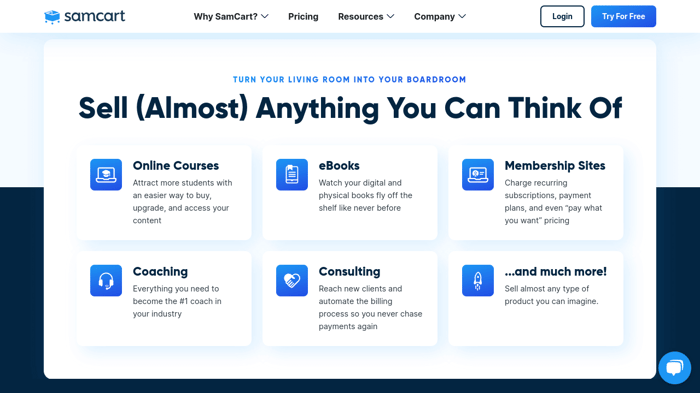
SamCart also promotes the fact that there are no restrictions on the number of products you can sell. However, because of the way the platform operates, you can’t sell bulk products as easily as you can with Shopify. Of course, this just means the platform is better suited to smaller businesses, entrepreneurs, coaches, or artists selling their wares.
Excellent Built-In Marketing Features
SamCart has great built-in marketing features like upsells, order bumps, and offers. They can be added easily with a single click and are very effective at boosting conversion rates. With the upsell feature, a customer is more likely to purchase an additional product complimentary to the one in their checkout, and special offers entice loyal customers to make additional purchases.
A really nice-to-have feature that SamCart incorporates is A/B split testing. This enables you to test variations of your checkout pages to see which is more appealing to users and will hopefully make them more likely to purchase your products.
Variety of Billing Options
You have a vast array of billing options you can offer to customers, from recurring subscriptions to one-off payments or a limited subscription. SamCart also offers an option to Pay What You Want, which is a unique feature that enables the customer to choose how much they want to pay for a product.
This might sound risky because there’s always a chance that the customer will pay way under the market price. But, more often than not, this can work in the seller's favor.
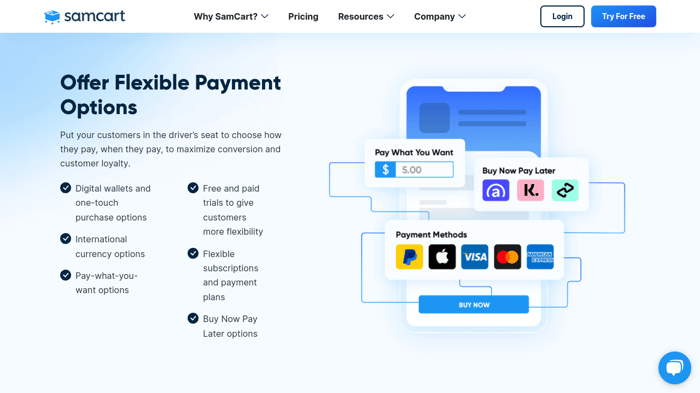
Additional Costs and Payment Processors
There are no hidden costs: you pay for your chosen plan, and there are 0% transaction fees to worry about. Because there are plenty of built-in features, you also don’t have to pay for additional apps.
The fact that SamCart does not charge any fees on transactions is a real positive since transaction fees can really eat into your profits. There are fewer payment options, with only PayPal and Stripe as available payment processors, but as these are two of the major payment processors, this is unlikely to be a major problem.
Limited Customer Service
SamCart’s customer support could certainly leave you wanting. For one, they only offer email support as standard with the plans. The variation between plans means that those paying for the higher tied plan will get a faster response to their email, whereas those on the lowest tier plan could be waiting awhile.
They do have an additional live chat add-on for $19/month where you can chat with a real human operator during business hours. But, of course, you may not be willing to shell out the significant additional cost.
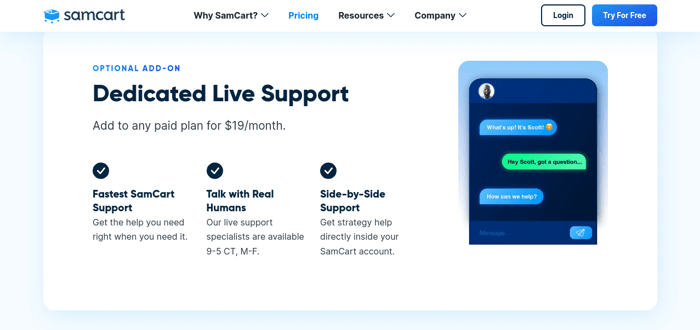
Blogging Functionality
Of the two platforms, only Shopify has built-in blogging functionality. However, that doesn’t mean the blogging functionality Shopify offers is top notch.
The blogging tool Shopify provides is free to use, but it’s a little too simple for anyone wanting to blog professionally to draw traffic to their store. However, the biggest downside would have to be the fact that you cannot inject shoppable products directly into your blog posts. Being able to promote products and link customers directly to checkout is a valuable asset – and ironically, Shopify lacks this.
And, of course, you can’t blog with SamCart – so what’s the workaround for professional blogging on both of these platforms? DropInBlog is the best option in both cases. DropInBlog is a professional blogging app that is platform agnostic, meaning it integrates with everything. DropInBlog can be found in the Shopify App Store, and to integrate with SamCart, you just have to copy and paste a short integration code.
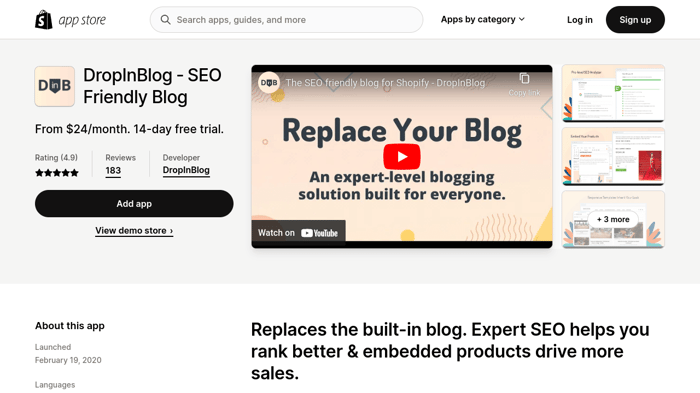
Benefits of Using DropInBlog
DropInBlog will automatically adopt your site CSS and style, so there’s no time wasted making everything look right before you publish each blog post. In addition, all of your content will be perfectly optimized for search engines thanks to the built-in SEO Analyzer. This tool assesses your content as you type and provides recommendations for improvement.
The content editor is similar in style to WordPress, which is familiar to many users and logical to use. There are plenty of other neat features to DropInBlog, like post scheduling and the ability to add multiple authors, manage comments, add social sharing buttons, and embed a variety of media types.
If you already have a collection of blog posts, it’s not a hassle – you can easily import and redirect them in seconds using DropInBlog.
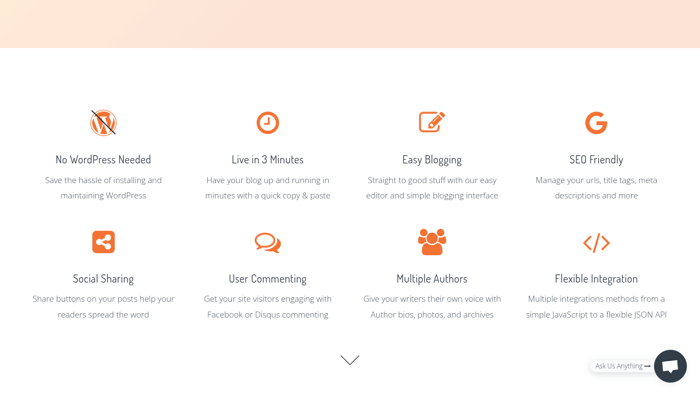
An added bonus is that with DropInBlog, you can directly inject products into a post so that they link to a checkout. This shortens the steps required for your customers to make a purchase, increasing the conversion potential.
FAQs
Is Shopify or SamCart better for beginners?
In terms of ease of use, SamCart will take less time to find your feet and start selling your products. Shopify isn’t really complicated, but it is known for being a little more detailed, and it often takes a little longer to learn the ropes.
In saying that, neither platform is terribly difficult to learn, so you should try to use the platform that best suits your needs.
Can I use my existing domain with both Shopify and Samcart?
It’s possible to use your existing domain with both Shopify and SamCart. Shopify provides helpful guidance for transferring a custom domain, and SamCart also has documentation covering the process of adding a custom domain.
Can I integrate DropInBlog with Shopify and SamCart platforms easily?
DropInBlog is very easy to integrate with both Shopify and Samcart. DropInBlog can be found in the Shopify App Store, and for SamCart you only need to copy and paste a couple of lines of code. The DropInBlog team even has an easy-to-follow tutorial to guide you through the process.
How easy is it to manage orders and shipping in Shopify vs. Samcart?
Samcart makes it easy to set up shipping settings, including applying restrictions based on geographical location. You can set your own shipping and handling costs, and they have an automated tax rates calculator to simplify things.
Shopify is probably on the higher end of the scale when it comes to shipping management. They have everything covered. You can fully customize shipping options, develop and print shipping labels, track orders, and manage international shipping and related taxes.
Final Thoughts
To end this Shopify vs. SamCart comparison, we’ll go over the key differences and things that stood out.
In terms of price, the two platforms are reasonably comparable, but the quality of customer support varies substantially. Shopify has a cheaper lower-tier plan and offers outstanding customer support options with tons of learning material online. In comparison, SamCart’s lowest-tier plan is more expensive but includes more built-in functionality. Customer support is definitely not one of SamCart’s strengths.
The two platforms have one major difference, with Shopify offering the full package of both a site builder and e-commerce management. On the other hand, SamCart is purely a sales checkout with marketing features built-in. Many of the built-in features with SamCart can only be acquired with an extension if using Shopify.
Overall, it seems that SamCart is best suited to entrepreneurs, coaches, or artists selling fewer products and wanting to spend less time managing a website. Conversely, Shopify is a robust e-commerce platform – it may not be pretty but it’s functional and highly scalable.
Shopify will work well for both small businesses and large businesses because it will grow with you. It’s also great if you have an existing brick-and-mortar store and want to branch out easily to online sales.
Hopefully, now you understand the key differences between Shopify and SamCart. If you were considering one over the other, now you should have a greater understanding of which will suit your needs better.




